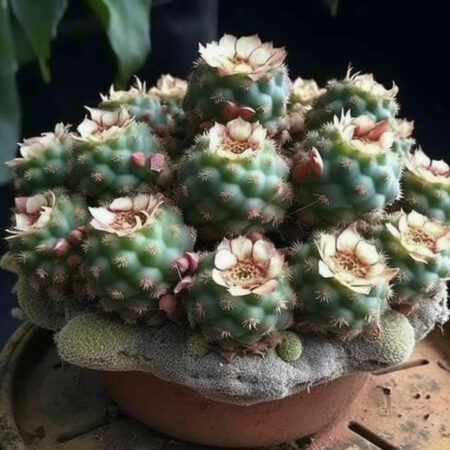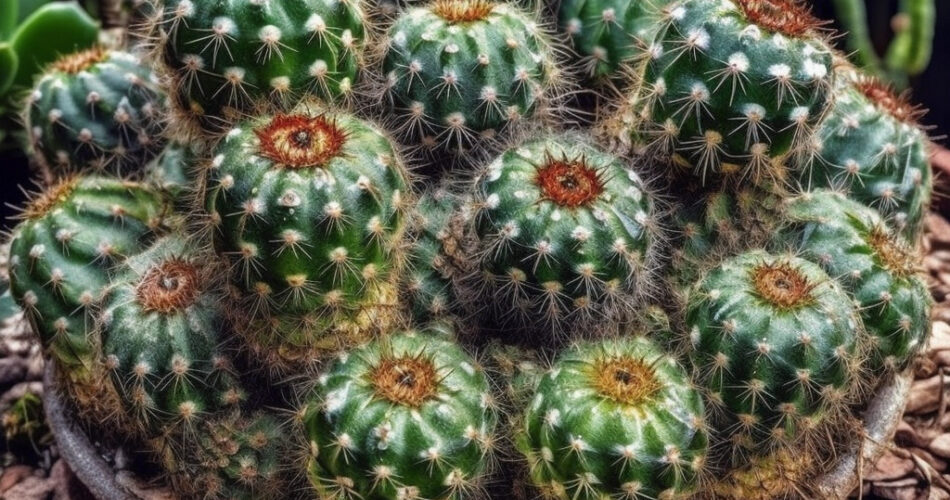Key Takeaways:
- Ancistrocactus is a genus of cacti known for their unique characteristics and beautiful flowers.
- Many species of this cactus are rare and endangered due to habitat destruction and overcollection.
- This cacti has remarkable adaptations for surviving in harsh desert environments, such as storing water in its stem and having dense spines for protection.
- When growing Ancistrocactus, it is important to select the right soil, containers, provide proper light and temperature conditions, and water and fertilize them correctly.
- It offers a wide range of visually stunning varieties that make them highly desirable among collectors.
- When acquiring Ancistrocactus plants, it is important to choose reliable sources that prioritize sustainable and legal practices.
- Proper care and display of Ancistrocactus, including regular inspections for pests or diseases, are essential for their overall health.
- This cactus has played a significant role in Native American folklore and traditions, and has also contributed to botanical discoveries and expeditions.
- Modern research and conservation efforts are dedicated to understanding and preserving Ancistrocactus species.
The Unique Characteristics of Ancistrocactus
Introduction to Ancistrocactus
Ancistrocactus is a genus of cacti that belongs to the family Cactaceae. Known for their unique characteristics and captivating beauty, Ancistrocactus has become a popular choice among cactus enthusiasts. These cacti are native to North America, particularly found in the southwestern regions of the United States and parts of northern Mexico.
One of the defining features of this cactus is its compact growth habit, making it an ideal choice for those with limited space. The plants generally have a globular or cylindrical shape and are adorned with numerous dense spines. The spines are usually short and stout, giving the cactus a distinctive appearance.
Another interesting characteristic of this cacti is its ability to produce beautiful flowers. The flowers bloom from the top of the plant and come in a variety of colors, including shades of pink, yellow, orange, and white. The flowers are typically tubular in shape and can add a burst of color to any cactus collection.
Rare and Endangered Status
While Ancistrocactus species are highly sought after by collectors, many of them are unfortunately rare and endangered in their natural habitats. The destruction of their native ecosystems, habitat fragmentation, and overcollection for horticultural purposes have all contributed to the decline in population numbers.
Several species of Ancistrocactus are currently listed under the Convention on International Trade in Endangered Species of Wild Fauna and Flora (CITES) as protected plants. It is essential for cactus enthusiasts and collectors to be aware of the conservation status of the species they acquire and to support conservation efforts aimed at preserving these unique cacti.
The Remarkable Adaptations
Ancistrocactus has developed several remarkable adaptations that allow it to thrive in harsh desert environments. One of the most notable adaptations is its ability to store water in its thick, succulent stem. This adaptation enables the plant to survive long periods of drought, making it well-suited for arid regions.
The dense spines covering the surface of Ancistrocactus serve multiple purposes. They help to protect the plant from excessive sunlight, reducing water loss through transpiration. The spines also act as a defense mechanism against herbivores, deterring animals from feeding on the cacti.
Ancistrocactus has also developed a shallow root system that spreads widely to maximize water absorption. The roots have the ability to quickly absorb water after rainfall, ensuring the survival of the plant during dry spells.
Growing Ancistrocactus: Tips and Tricks
Choosing the Right Soil and Containers
When it comes to growing Ancistrocactus, selecting the right soil and containers is crucial for the plant’s overall health and well-being. These cacti thrive in well-draining soil that replicates their natural habitat. A mixture of cactus potting soil, sand, and perlite can provide the ideal growing medium.
Ancistrocactus prefers shallow containers with sufficient drainage holes to prevent water from pooling at the roots. The containers should be wide enough to accommodate the cactus and allow for some room for growth.
The Ideal Light and Temperature Conditions
Light plays a crucial role in the growth and development of Ancistrocactus. These cacti require bright, indirect sunlight to thrive. Placing them near a south- or east-facing window can provide the optimal amount of sunlight. However, it is important to avoid direct exposure to intense sunlight as it may lead to sunburn on the cactus.
In terms of temperature, Ancistrocactus prefers warm climates. During the growing season, temperatures between 70°F to 85°F (21°C to 29°C) are ideal. In the winter, a cooler period with temperatures around 50°F to 60°F (10°C to 15°C) can help promote blooming.
Watering and Fertilizing Ancistrocactus: Best Practices
Proper watering and fertilization are crucial for the health and flourishing of this type of cacti. These cacti have specific water requirements and should be watered sparingly. Overwatering can lead to root rot and other issues.
During the active growing season, which typically occurs in spring and summer, water Ancistrocactus when the soil is completely dry. Apply water slowly and allow it to soak into the soil without leaving the cactus sitting in excess water. In the dormant winter months, reduce watering frequency significantly to mimic the plant’s natural rest period.
When it comes to fertilization, a balanced cactus fertilizer diluted to half strength can be applied once every two to four weeks during the growing season. It is important to follow the package instructions and avoid excessive fertilization, as this can harm the cactus.

Ancistrocactus as a Collectible Cactus
Exploring the Wide Varieties of Ancistrocactus
Ancistrocactus offers a wide range of unique and visually stunning varieties that make them highly desirable among collectors. Each species and variety within the Ancistrocactus genus has its own distinct features, including variations in spines, flower colors, and growth habits.
Some popular Ancistrocactus species among collectors include Ancistrocactus capricornensis, Ancistrocactus scheeri, and Ancistrocactus tobuschii. Each of these species possesses its own charm and beauty, making them a valuable addition to any cactus collection.
Where to Find and Purchase Ancistrocactus for Your Collection
Acquiring Ancistrocactus plants for your collection can be an exciting endeavor. There are several reputable nurseries, online sellers, and specialized cactus societies that offer a wide variety of Ancistrocactus species and hybrids.
When purchasing Ancistrocactus, it is important to choose reliable sources that prioritize sustainable and legal practices. Look for nurseries that propagate their plants responsibly and are transparent about the origins of their specimens. This ensures that you are acquiring healthy and ethically sourced Ancistrocactus for your collection.
Caring for and Displaying your Ancistrocactus Collection
Once you have acquired Ancistrocactus plants, it is essential to provide them with the proper care and display them in a way that showcases their beauty. Creating a suitable environment for your collection will contribute to their overall health and enjoyment.
When displaying Ancistrocactus, consider their light and temperature requirements. Ensure they are placed in a well-lit area but protected from intense sunlight. Grouping them with other cacti that have similar care needs can create a visually appealing arrangement.
Regularly inspect your Ancistrocactus for signs of pests or diseases. Spider mites and mealybugs are common pests that can infest cacti. Should you spot any issues, take appropriate measures to address the problem before it spreads to other plants in your collection.
Discovering the Fascinating World of Ancistrocactus Through History and Mythology
Ancistrocactus in Native American Folklore and Traditions
Ancistrocactus has played a significant role in Native American folklore and traditions. Some tribes believe that these cacti possess spiritual and healing properties, associating them with luck, protection, and warding off evil spirits.
For example, the Zuni people of New Mexico consider Ancistrocactus as a sacred plant and use it in various healing rituals. They believe that the cactus has the power to restore vitality and promote physical and spiritual well-being.
The Role of This Cactus in Botanical Discoveries and Expeditions
Ancistrocactus has also played a vital role in botanical discoveries and expeditions. Over the years, explorers and botanists have ventured into the desert regions of North America, documenting and studying the unique flora found in these areas.
Through their discoveries, new species of Ancistrocactus have been identified and classified, contributing to the understanding and conservation of this diverse genus. The exploration of these delicate ecosystems has provided valuable insights into the adaptations and ecological role of Ancistrocactus in their natural habitats.
Modern Research and Conservation Efforts
As the interest in cactus conservation grows, so does the research and conservation efforts dedicated to Ancistrocactus. Scientists and conservation organizations are actively studying these unique cacti to gain a deeper understanding of their ecology, genetics, and conservation needs.
Through these efforts, approaches to habitat preservation, restoration, and sustainable propagation have been developed to protect the endangered species of Ancistrocactus. Collaboration between researchers, conservationists, and enthusiasts is crucial in ensuring the survival and continuous enjoyment of these fascinating cacti for generations to come.
Ancistrocactus offers a captivating journey into the world of unique cacti. From their distinct characteristics and adaptations to cultivation tips and their cultural significance, this comprehensive guide provides a holistic understanding of Ancistrocactus. Whether you are a cactus enthusiast, collector, or simply intrigued by the wonders of the natural world, exploring the fascinating world of Ancistrocactus is an experience that will leave you captivated and inspired.




Comments